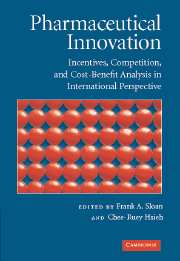 Pharmaceutical Innovation
Pharmaceutical Innovation Book contents
- Frontmatter
- Contents
- List of Tables
- List of Figures
- Contributors
- Acknowledgments
- PHARMACEUTICAL INNOVATION
- 1 Introduction
- PART I THE INDUSTRY STRUCTURE OF PHARMACEUTICAL INNOVATION
- PART II STRUCTURING INCENTIVES FOR RESEARCH AND DEVELOPMENT
- 4 Drugs for Neglected Diseases: New Incentives for Innovation
- 5 When Patents Fail: Finding New Drugs for the Developing World
- 6 Implementing a Public Subsidy for Vaccines
- 7 Ensuring the Future Supply of Vaccines: Is a National Vaccine Authority the Answer?
- PART III COMPETITION AND MARKETING
- PART IV PUBLIC EVALUATION OF THE BENEFITS AND COSTS OF INNOVATION
- Notes
- References
- Index
5 - When Patents Fail: Finding New Drugs for the Developing World
Published online by Cambridge University Press: 18 December 2009
- Frontmatter
- Contents
- List of Tables
- List of Figures
- Contributors
- Acknowledgments
- PHARMACEUTICAL INNOVATION
- 1 Introduction
- PART I THE INDUSTRY STRUCTURE OF PHARMACEUTICAL INNOVATION
- PART II STRUCTURING INCENTIVES FOR RESEARCH AND DEVELOPMENT
- 4 Drugs for Neglected Diseases: New Incentives for Innovation
- 5 When Patents Fail: Finding New Drugs for the Developing World
- 6 Implementing a Public Subsidy for Vaccines
- 7 Ensuring the Future Supply of Vaccines: Is a National Vaccine Authority the Answer?
- PART III COMPETITION AND MARKETING
- PART IV PUBLIC EVALUATION OF THE BENEFITS AND COSTS OF INNOVATION
- Notes
- References
- Index
Summary
Introduction
High-income nations use patent incentives to fund most new drug discovery. However, most victims of tropical diseases are unable to pay prices high enough to cover the research and development (R&D) costs of new medicines (Hollis, Chapter 4). Thus, foundations and governments in high-income nations (hereinafter collectively “sponsors”) must fill the gap. Before the 1990s, sponsors spent about $50 million per year on worldwide drug discovery for neglected diseases. This figure was clearly inadequate in a world where per-drug R&D costs averaged $802 million (DiMasi, Hansen, and Grabowski 2003). Predictably, R&D results were practically nonexistent. Indeed, just 12 of the 1,233 “new chemical entities” licensed worldwide between 1975 and 1997 were approved to treat tropical diseases in humans (Kremer and Glennerster 2004). Fortunately, recent developments are more hopeful. Worldwide R&D spending on diseases of poverty could reach $500 million per year by decade's end (Ridley 2004). While this level of funding is still small by commercial standards, it is at least plausible. The challenge now is for sponsors to get the most “bang” from every dollar spent.
Given that ordinary patent incentives do not work, what new incentives should sponsors create to supplement or replace them? Section II introduces the main proposals that have been suggested. The first category, denoted “end-to-end” strategies, consists of proposals in which sponsors mimic the patent system by announcing a single reward for researchers who successfully complete the entire drug discovery pipeline.
- Type
- Chapter
- Information
- Pharmaceutical InnovationIncentives, Competition, and Cost-Benefit Analysis in International Perspective, pp. 91 - 106Publisher: Cambridge University PressPrint publication year: 2007
